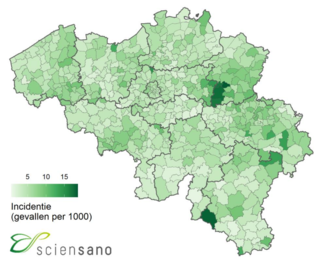
A ventilator is a type of breathing apparatus, a class of medical technology that provides mechanical ventilation by moving breathable air into and out of the lungs, to deliver breaths to a patient who is physically unable to breathe, or breathing insufficiently. Ventilators may be computerized microprocessor-controlled machines, but patients can also be ventilated with a simple, hand-operated bag valve mask. Ventilators are chiefly used in intensive-care medicine, home care, and emergency medicine and in anesthesiology.

The COVID-19 pandemic, also known as the coronavirus pandemic, is a global pandemic of coronavirus disease 2019 (COVID-19) caused by severe acute respiratory syndrome coronavirus 2 (SARS-CoV-2). The novel virus was first identified in an outbreak in the Chinese city of Wuhan in December 2019, and spread to other areas of Asia and then worldwide in early 2020. The World Health Organization (WHO) declared the outbreak a public health emergency of international concern (PHEIC) on 30 January 2020. The WHO ended its PHEIC declaration on 5 May 2023. As of 19 February 2024, the pandemic has caused 774,493,392 cases and 7,026,534 confirmed deaths, ranking it fifth in the list of the deadliest epidemics and pandemics in history.

The COVID-19 pandemic has had far-reaching consequences beyond the spread of the disease itself and efforts to quarantine it, including political, cultural, and social implications.

The COVID-19 pandemic in Taiwan was a part of the worldwide pandemic of coronavirus disease 2019 caused by severe acute respiratory syndrome coronavirus 2. As of 19 March 2023 in Taiwan, 10,231,343 are confirmed cases, including 18,775 deaths.

The COVID-19 pandemic in the United Kingdom is a part of the worldwide pandemic of coronavirus disease 2019 (COVID-19) caused by severe acute respiratory syndrome coronavirus 2 (SARS-CoV-2). In the United Kingdom, it has resulted in 24,892,903 confirmed cases, and is associated with 232,112 deaths.

The COVID-19 pandemic in Poland was a part of the worldwide pandemic of coronavirus disease 2019 caused by severe acute respiratory syndrome coronavirus 2. In February and March 2020, health authorities in Poland carried out laboratory testing of suspected cases of infection by SARS-CoV-2, as well as home quarantining and monitoring. On 4 March 2020, the first laboratory confirmed case in Poland was announced in a man hospitalised in Zielona Góra. On March 10, 2020, the World Health Organization declared the local transmission phase of SARS-CoV-2 in Poland. On March 12, 2020, the first death from coronavirus disease 2019 (COVID-19) in Poland was that of a 57-year-old woman.

The COVID-19 pandemic in Belgium has resulted in 4,855,952 confirmed cases of COVID-19 and 34,339 deaths.

The COVID-19 pandemic in the Czech Republic was a part of the worldwide pandemic of coronavirus disease 2019 caused by severe acute respiratory syndrome coronavirus 2. The first three confirmed cases in the Czech Republic were reported on 1 March 2020. On 12 March, the government declared a state of emergency, for the first time in the country's modern history for the area of the entire country. On 16 March, the country closed its borders, forbade the entry of foreigners without residence permits, and issued a nationwide curfew. While originally planned to be in effect until 24 March, the measures were later extended until 1 April and then again until the end of State of Emergency which was extended by the Chamber of Deputies until 30 April 2020 and then again until 17 May 2020.

The COVID-19 pandemic in Slovenia was a part of the pandemic of coronavirus disease 2019 caused by severe acute respiratory syndrome coronavirus 2. The first slovenian citizen to be infected was resulted positive on 3 March 2020, the infection was contracted during an internal flight in Italy. The first case in Slovenia was confirmed a day later; it was an imported case transmitted by a tourist traveling from Morocco via Italy. Italy was the center of the SARS-CoV-2 in Europe at the time.

The COVID-19 pandemic in Scotland is part of the COVID-19 pandemic of coronavirus disease-2019, caused by the virus SARS-CoV-2. The first case of COVID-19 was confirmed in Scotland on 1 March 2020. Community transmission was first reported on 11 March 2020, and the first confirmed death was on 13 March 2020.

Hazard controls for COVID-19 in workplaces are the application of occupational safety and health methodologies for hazard controls to the prevention of COVID-19. Vaccination is the most effective way to protect against severe illness or death from COVID-19. Multiple layers of controls are recommended, including measures such as remote work and flextime, increased ventilation, personal protective equipment (PPE) and face coverings, social distancing, and enhanced cleaning programs.

Shortages related to the COVID-19 pandemic are pandemic-related disruptions to goods production and distribution, insufficient inventories, and disruptions to workplaces caused by infections and public policy.
Exercise Cygnus was a three-day simulation exercise carried out by the UK Government in October 2016 to estimate the impact of a hypothetical H2N2 influenza pandemic on the United Kingdom. It aimed to identify strengths and weaknesses within the United Kingdom health system and emergency response chain by putting it under significant strain, providing insight on the country's resilience and any future ameliorations required. It was conducted by Public Health England representing the Department of Health and Social Care, as part of a project led by the "Emergency Preparedness, Resilience and Response Partnership Group". Twelve government departments across Scotland, Wales and Northern Ireland, as well as local resilience forums (LRFs) participated. More than 950 workers from those organisations, prisons and local or central government were involved during the three-day simulation, and their ability to cope under situations of high medical stress was tested.
Planning and preparing for pandemics has happened in countries and international organizations. The World Health Organization writes recommendations and guidelines, though there is no sustained mechanism to review countries' preparedness for epidemics and their rapid response abilities. National action depends on national governments. In 2005–2006, before the 2009 swine flu pandemic and during the decade following it, the governments in the United States, France, UK, and others managed strategic health equipment stocks, but they often reduced stocks after the 2009 pandemic in order to reduce costs.

The COVID-19 pandemic has impacted hospitals around the world. Many hospitals have scaled back or postponed non-emergency care. This has medical consequences for the people served by the hospitals, and it has financial consequences for the hospitals. Health and social systems across the globe are struggling to cope. The situation is especially challenging in humanitarian, fragile and low-income country contexts, where health and social systems are already weak. Health facilities in many places are closing or limiting services. Services to provide sexual and reproductive health care risk being sidelined, which will lead to higher maternal mortality and morbidity. The pandemic also resulted in the imposition of COVID-19 vaccine mandates in places such as California and New York for all public workers, including hospital staff.

The COVID-19 pandemic has impacted healthcare workers physically and psychologically. Healthcare workers are more vulnerable to COVID-19 infection than the general population due to frequent contact with infected individuals. Healthcare workers have been required to work under stressful conditions without proper protective equipment, and make difficult decisions involving ethical implications. Health and social systems across the globe are struggling to cope. The situation is especially challenging in humanitarian, fragile and low-income country contexts, where health and social systems are already weak. Services to provide sexual and reproductive health care risk being sidelined, which will lead to higher maternal mortality and morbidity.

Part of managing an infectious disease outbreak is trying to delay and decrease the epidemic peak, known as flattening the epidemic curve. This decreases the risk of health services being overwhelmed and provides more time for vaccines and treatments to be developed. Non-pharmaceutical interventions that may manage the outbreak include personal preventive measures such as hand hygiene, wearing face masks, and self-quarantine; community measures aimed at physical distancing such as closing schools and cancelling mass gathering events; community engagement to encourage acceptance and participation in such interventions; as well as environmental measures such surface cleaning. It has also been suggested that improving ventilation and managing exposure duration can reduce transmission.

The Hussain Dawood Pledge (HD-Pledge) is one of the biggest private donations and initiatives to fight against the COVID-19 pandemic in Pakistan. Hussain Dawood, on behalf of Engro, Dawood Hercules and his family pledged on 2 April 2020 a contribution in services, kind, and cash of Pakistani rupee (PKR) 1 billion . The contribution became public a day after Prime Minister Imran Khan announced the coronavirus relief fund to fight the pandemic and urged everyone to donate.
The following is a timeline of the COVID-19 pandemic in Alberta.

The United Kingdom's response to the COVID-19 pandemic consists of various measures by the healthcare community, the British and devolved governments, the military and the research sector.


















